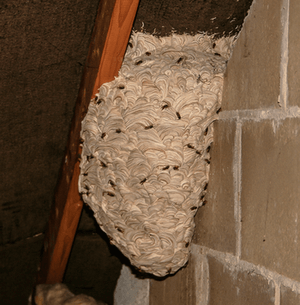Questions answered about wasps - Page:10
Do wasp nests smell?
Generally speaking, no. Wasp nests do not have a particular smell.
However, occasionally if a large amount of insect food is carried into the nest, or in hot weather when workers are bringing a lot of water into the nest to cool it down, the nest can become saturated at the bottom of the nest. It can smell musty or mouldy if it does not dry out quickly. Occasionally, nests touch plasterboard (ceilings or walls), and this moisture can seep through and stain. In bad cases, the plasterboard can slop off and expose the nest.
Do you work in the evenings?
Yes, not a problem, we can fit in jobs to suit you.
Wasps in loft
If it is springtime and you are getting wasps in the loft, or they are getting in the house via the attic, it will be queens.
Loft spaces are ideal places for queen wasps to hibernate over winter. As soon as the weather starts to warm up, these queens will begin to emerge from hibernation.
They need to feed right away, or they will starve. Sometimes queens make mistakes and find their way inside the house instead of outside. They can be a nuisance, but this will not continue long.

What kind of nest looks like mud on the wall?
This is most likely to be a bird's nest. Birds such as house martins build nests that look similar to wasp nests but are made from mud.
Wasp nests are made from chewed wood, almost like paper mache.
A wasp nest usually is light grey with swirl marks across it.
In the United States and Canada, wasps called Mud daubers build small nests from mud. For more information visit Mud dauber wasp
Are you able to kill wasps without direct access to the nest?
Yes, we do not necessarily need to see the nest to kill it. We can take several different approaches when tackling a wasp nest.
As long as you see wasps entering, we can kill them, so you do not need to find the nest.
